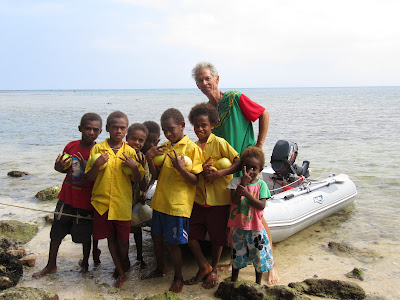Naghol,
the land diving ceremony, takes place in three locations at the south
end of Pentecost Island for a short
time each year to
ensure a successful yam harvest.
Witnessing this spectacle was high on our agenda, and
it was indeed amazing. The previous
post had some photos of
the jumping and
background information;
here’s a bit more.
Preparation includes digging up the earth beneath the tower. Vine lengths are adjusted carefully, but the spaded ground provides a softer landing in case a vine is slightly too long and the jumper lands on his head.
 |
| ...and vine length at the bottom |
 |
| Tying vines around a jumper's ankles (photos of jumping appear in the post entitled Vanuatu Snapshots) |
And the charming child at the start of this post was one of the dancers.
With only 8 guests attending, experiencing this ancient tradition
felt intimate and powerful.
Continuing up the west coast of Pentecost, we stopped briefly at
Waterfall Bay. Barter is more common in outlying villages than cash,
and we traded a fishing knife for a guided walk (guides are required)
to the beautiful cascade.
The path passes through the community garden; this gate keeps pigs
and cows away from the root vegetables. Deciphering Bislama, the sign
reads “when you open the gate to go swimming, please you must shut
the gate”.
Loltong, our last stop on Pentecost, was hosting the island’s soccer tournament when we arrived.
Like sporting events in the U.S., this one had food stalls (though
the menu of fish and rice would probably not be as popular in the
States)
 |
| Kava roots used to be chewed prior to soaking them in water for the "brew", but now they are ground in a meat grinder (there's something to be said for progress!) |
We landed our dinghy at the remains of an old wharf and hiked with
our instruments up to a primary school to play for them. They thanked
us by gathering lots of pamplemousse (grapefruit)—our favorite
fruit, and it lasted for ages (fortunately, since they gave us so many!).
When we left the wharf an older man holding a toddler was there, with
several other people nearby. I asked the man if they were his family.
Smiling, he said “Yes, but in Vanuatu, we are all brothers”: a
statement both beautiful and palpably true.
MAEWO ISLAND
The west coast of Maewo Island has one outstanding anchorage, both in terms of beauty and safety. We greatly enjoyed the small bay and village of Asanvari, and ended up staying several days; in retrospect, it is still one of our favorite places.
Everyone appreciated our music immensely, asking us to play several
times, and in return invited us to attend a special feast to
celebrate the installation of the new chief. We felt immensely
honored. Photos would have been inappropriate (to say nothing of
difficult in the near darkness), but sharing communal food unearthed
from a pit lined with rocks—with leaves as plates, and without
utensils—in that setting was a deeply memorable experience.
This generator was supposed to provide electricity for a "yacht club" for visiting boats, but neither the generator nor the club was operational. Specialty items like generators and solar regulators don't come with tools or maintenance training, so when they stop working the local owners are often at a loss. Art helps whenever he can, and managed to fix part of this generator.
 |
| In every village we visited, people are summoned to school and to church by clanging on an old gas cylinder |
 |
| Playing for an avid audience: students, and everyone else in the area who heard something they'd never heard before and came running (photo taken on my camera by 4th grader Max) |
This young girl, trying to look formal for a photo, is in typical
attire: a skirt but no shirt, a woven bag (used for holding
snacks—usually cooked roots—and carried by everyone, regardless
of age or gender), and a small bush knife. Even toddlers use knives;
who knows when you might need to whack a vine out of the way, or lop
off a piece of fruit?
We were reluctant to leave such a peaceful and beautiful place…





















